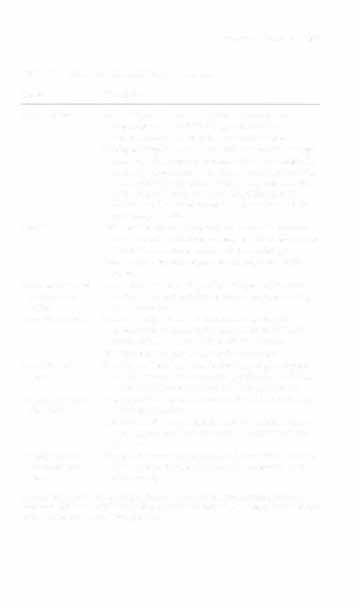i bc27f85be50b71b1 (204 page)
Read i bc27f85be50b71b1 Online
Authors: Unknown

654
ACUTE CARr HANDBOO .... FOR PHY,KAI Tl-lfRAPI,'P;
Table 11-2. Thyroid Hormone Tests
Hormone
Test Description
Normal Value
Serum thyroxine
Radioimmunoassay
4-12 �gldl
(RIA) measuremelll.
Serum triiodo
RIA measuremcnt.
40-204 ngldl
thyronine
Free thyroxine indcx
Direct RIA measurc
Direct' 0.8-2.7 nglml
ment or indirect
Indirec" 4.6- 1 1.2 ng/ml
calculated measurememo
Thyroid-stimulating
Radioisotope and
0.4-8.9 pU/ml
hormone (TSH)
chemical bhelmg
measurcment.
Thyrotropin-releasing
Intravenous admll1is
Normal rise In men and
hormone (TRH)
tration of TRH to
womcn iii 6 pU/ml
TRH augments the
patients.
above basellllc TSH
function of TSII
The expected
levels.
in patients with
response is a rise in
Normal rise in men older
hypothyroidism.
TSH levels.
than 40 years IS 2 �U/
Only performed 111
rut above basehne.
difficult diagnos
Hypothyroidism is mdiric cases.
cated by Increased
response to TRH.
Hypcrrhyroidism is indicated hy no response to
TRH.
Sources: Data frolll WM Burch (cd). Endocrinology for Ihe House Officer (2nd cd).
Baltimore: Williams & Wilkins, 1988; 1: JV Corbett (cd). LaboratOry Te:.t!. and Dla{tnosric Procedures with Nursing Diagnoses (5th cd). Upper Saddle River. NJ: Prentice Hall Health. 2000;409-413; LM Malarke)', ME McMorrow (cds). Nur\C's 1\tanual of
Laborarory Tests and Diagnostic Procedures. ))hilJ.ddphia: Saunders, 2000;604-612.
and RA Sacher, RA MtPherson, J1\1 Campos (eds), Widman's Clinical 1mcrprctaU0l1 of
Laboratory Tcsrs (II rh cd). Philadelphia: FA Davis, 2000;786-791.
they are metabolically active by themselves. Thyroxine-binding globulin (TBG) is the major thyroid transport protein. Serum levels of T4
and T3 are usually measured by RIA. Table 11-2 describes the tests
used to measure thyroid hormones, and Table I 1 -3 summarizes other
tests used to measure thyroid function.


ENDOCRINE. SYSTEM
655
Table 11-3. Thyroid Function Tests
Test
Description
Triiodothyronine
RT3U indirectly measures rhe number of unoccupied
resin uptake
protein binding sites for serum thyroxine (T4) and
(RT3U)
serum triiodothyronine (T3) by using radioisotopes.
RT3U qualifies levels of bound versus unbound T4 and
T3. Thyroid hormone uptake is high with hyperthyroidism and low wirh hypothyroidism.
Thyroidal 24·hr
Used to determine mecabolic activity of the thyroid
radioactive
gland. Radioactive iodine is administered, and the periodine uptake
centage of tOtal administered radioactive iodine taken
lip by the thyroid in 24 hrs is then calculated.
Normal radioactive iodine uptake is 5-30%.
Hypothyroidism results in reduced uptake.
Thyroid imaging
Intravenous administration of radionuclides allows
or scan
imaging or scanning of particular areas of the thyroid gland.
Increased or decreased uptake of the radionuclide can
help diagnose dysfunction.
Ultrasound
Nodules of rhe thyroid gland that are palpable or suspected may be delineated as cystic or solid lesions by
ultrasound.
Needle biopsy
Fine needle aspiration of thyroid cells may help diagno�e
a suspected neoplasm.
Sources: Data from WM Burch (ed). Endocrinology for the House Officer (2nd ed).
Baltimore: Williams & Wilkins, 1988;1; M Harrog ted). Endocrinology. Oxford, UK:
Blackwell Sciemific, 1987;25; ;:Inc! RA Sacher, RA McPherson,JM Campos (eds). Widman's Clinic
2000;786-793.
Clinical Tip
• Low levels of thyroid hormones T3 or T4 may result in
weakness, muscle aching, and stiffness. Based on this
information, the physical therapist may decide to alter
treatment parameters by decreasing the treatment intensity
to optimize activity tolerance, minimize patient discomfort, or both.


656
Aa..rrE CARE HANDBOOK FOR PHYSICAL TlIERAI'ISTS
• Patients may be on bed rest or precautions after radionuclide studies. The physical therapist should refer to the physician's orders after testing to clarify the patient's
mobility status.
Thyroid Disorders
Disorders of the thyroid gland result from a variety of causes and can
be classified as hyper- or hypothyroidism.
Hyperthyroidism
Hyperthyroidism, or thyrotoxicosis, is characterized by excessive
sympathomimetic and catabolic activity resulting from overexposure
of tissues ro thyroid hormones. The most common causes of hyperthyroidism are outlined in Table 11-4.
General signs and symptOms of hyperthyroidism include rhe
foIlO\vingl,6:
• Nervousness, irritation, and emotional lability
• Fatigue, weakness, and weight loss despite normal or increased
appetite
• Palpitations, atrial fibrillation (common above the age of 60
years), and tachycardia (heart rate of more than 90 beats per
minute at rest)
• Increased perspiration, moist and warm hands, and smooth and
vel very skin
• Heat lmolerance
• Diarrhea
• Menstrual dysfunction
• Presence of goiter
• Tremor
• Lid lag, retraction, or both
• "Plumber's nails" (onycholysis)
•
Thyroid bruit



ENOOCRINE SYSTEM
657
Table 1 1-4. Common Causes of Hyperthyroidism
Cause
Description
Graves' disease
A familial, auroimmune disorder responsible for
approximately 80-90% of hyperthyroid cases.
Occurs more commonly in women than men.
Distinguishing features include diffuse thyroid enlargement, ophthalmopathy (double vision and sensitivity
to light), exophthalmos (excessive prominence of the
eyes), pretibial myxedema (thickening, redness, and
puckering of skin in the front of the tibia), atrial
fibrillation, fine hand tremors, and weakness of the
quadriceps muscle.
Thyroiditis
Inflammation of the thyroid gland can result from an
acute bacterial infection, a subacute viral infection, or
chronic inflammation with unknown etiology.
Pain may or may nor be present on palpation of rhe
gland.
Toxic nodular and
Areas of the enlarged thyroid gland (goiter) become
